Comprehensive insights into the application of graphene-based aerogels for metals removal from aqueous media: Surface chemistry, mechanisms, and key features
IF 15.9
1区 化学
Q1 CHEMISTRY, PHYSICAL
引用次数: 0
Abstract
Efficient removal of heavy metals and other toxic metal pollutants from wastewater is essential to protect human health and the surrounding vulnerable ecosystems. Therefore, significant efforts have been invested in developing practical and sustainable tools to address this issue, including high-performance adsorbents. In this respect, within the last few years, graphene-based aerogels/xerogels/cryogels (GBAs) have emerged and drawn significant attention as excellent materials for removing and recovering harmful and valuable metals from different aqueous media. Such an upward trend is mainly due to the features of the aerogel materials combined with the properties of the graphene derivatives within the aerogel’s network, including the GBAs’ unique three-dimensional (3D) porous structure, high porosity, low density, large specific surface area, exceptional electron mobility, adjustable and rich surface chemistry, remarkable mechanical features, and tremendous stability. This review offers a comprehensive analysis of the fundamental and practical aspects and phenomena related to the application of GBAs for metals removal. Herein, we cover all types of (bottom-up) synthesized GBAs, including true microporous graphene-based aerogels as well as other 3D graphene-based open-cell interconnected mesoporous and macroporous aerogels, foams, and sponges. Indeed, we provide insights into the fundamental understanding of the GBAs’ suitability for such an important application by revealing the mechanisms involved in metals removal and the factors inducing and controlling the highly selective behavior of these distinctive adsorbents. Besides conventional adsorptive pathways, we critically analyzed the ability of GBAs to electrochemically capture metal pollutants (i.e., electrosorption) as well as their efficiency in metals detoxification through reductive mechanisms (i.e., adsorption-reduction-readsorption). We also covered the reusability aspect of graphene aerogels (GAs)-based adsorbents, which is strongly linked to the GBAs’ outstanding stability and efficient desorption of captured metals. Furthermore, in view of their numerous practical and environmental benefits, the development and application of magnetically recoverable GAs for metals removal is also highlighted. Moreover, we shed light on the potential practical and scalable implementation of GBAs by evaluating their performance in continuous metals removal processes while highlighting the GBAs’ versatility demonstrated by their ability to remove multiple contaminants along with metal pollutants from wastewater media. Finally, this review provides readers with an accessible overview and critical discussion of major recent achievements regarding the development and applications of GAs-based adsorbents for metal ions removal. Along with our recommendations and suggestions for potential future work and new research directions and opportunities, this review aims to serve as a valuable resource for researchers in the field of wastewater treatment and inspire further progress towards developing next-generation high-performance GBAs and expanding their application.
全面了解石墨烯基气凝胶在去除水介质中金属方面的应用:表面化学、机理和关键特征。
有效去除废水中的重金属和其他有毒金属污染物对于保护人类健康和周围脆弱的生态系统至关重要。因此,人们投入了大量精力来开发实用且可持续的工具,包括高性能吸附剂,以解决这一问题。在这方面,过去几年中,石墨烯基气凝胶/气凝胶/晶体凝胶(GBAs)作为从不同水介质中去除和回收有害金属和有价金属的极佳材料崭露头角,并引起了广泛关注。这种上升趋势主要是由于气凝胶材料的特性与气凝胶网络中石墨烯衍生物的特性相结合,包括气凝胶独特的三维(3D)多孔结构、高孔隙率、低密度、大比表面积、优异的电子迁移率、可调且丰富的表面化学性质、显著的机械特性和极高的稳定性。本综述全面分析了与应用 GBAs 去除金属有关的基本和实际方面及现象。在此,我们将介绍所有类型的(自下而上)合成 GBA,包括真正的微孔石墨烯基气凝胶以及其他三维石墨烯基开孔互连介孔和大孔气凝胶、泡沫和海绵。事实上,通过揭示金属去除的相关机制以及诱导和控制这些独特吸附剂高选择性行为的因素,我们深入了解了石墨烯基气凝胶在如此重要的应用中的适用性。除了传统的吸附途径外,我们还严格分析了 GBAs 电化学捕获金属污染物(即电吸附)的能力,以及它们通过还原机制(即吸附-还原-再吸附)进行金属解毒的效率。我们还研究了基于石墨烯气凝胶(GAs)的吸附剂的可重复使用性,这与石墨烯气凝胶(GBAs)出色的稳定性和捕获金属的高效解吸能力密切相关。此外,鉴于磁性可回收石墨烯气凝胶具有诸多实用和环境效益,我们还重点介绍了其在去除金属方面的开发和应用。此外,我们还通过评估 GBAs 在连续金属去除过程中的性能,阐明了其潜在的实用性和可扩展性,同时强调了 GBAs 的多功能性,这体现在它们能够去除废水介质中的多种污染物和金属污染物。最后,本综述为读者提供了有关开发和应用基于 GAs 的吸附剂去除金属离子的最新主要成就的概览和批判性讨论。本综述旨在为废水处理领域的研究人员提供宝贵的资源,并激励他们在开发下一代高性能 GBAs 和扩大其应用领域方面取得更大进展。
本文章由计算机程序翻译,如有差异,请以英文原文为准。
求助全文
约1分钟内获得全文
求助全文
来源期刊
CiteScore
28.50
自引率
2.60%
发文量
175
审稿时长
31 days
期刊介绍:
"Advances in Colloid and Interface Science" is an international journal that focuses on experimental and theoretical developments in interfacial and colloidal phenomena. The journal covers a wide range of disciplines including biology, chemistry, physics, and technology.
The journal accepts review articles on any topic within the scope of colloid and interface science. These articles should provide an in-depth analysis of the subject matter, offering a critical review of the current state of the field. The author's informed opinion on the topic should also be included. The manuscript should compare and contrast ideas found in the reviewed literature and address the limitations of these ideas.
Typically, the articles published in this journal are written by recognized experts in the field.

 求助内容:
求助内容: 应助结果提醒方式:
应助结果提醒方式:


